Australian Joint Copying Project research guide
About the AJCP
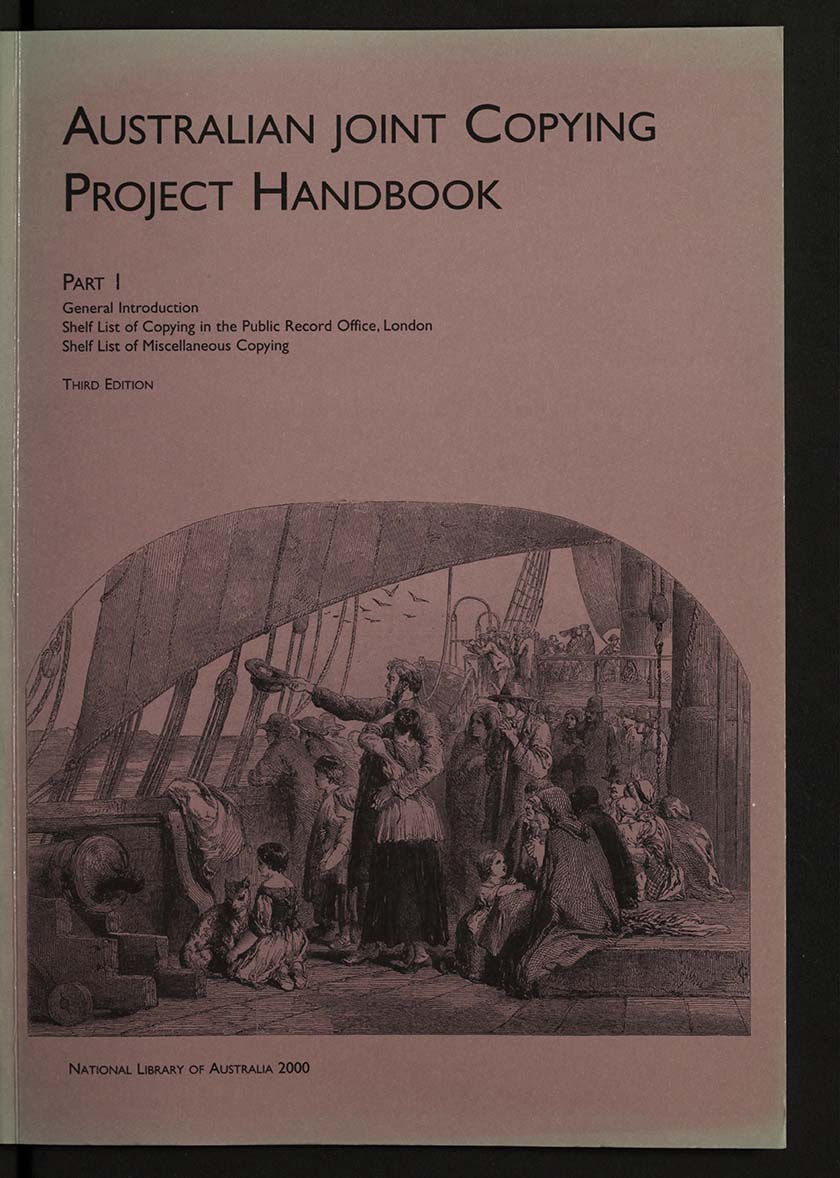
Mary McCallum & National Library of Australia & Australian Joint Copying Project, (2000), Australian Joint Copying Project handbook, nla.gov.au/nla.obj-396880406
The Australian Joint Copying Project is a collection of historical material relating to Australia, New Zealand and the Pacific dating from 1560 to 1984.
The material has been drawn from records held in the United Kingdom and microfilmed. The collection comprises 10,095 reels of 35mm microfilm.
The microfilms in the collection are divided into two series:
- Public Records Office (PRO) - copied from records held in the UK Public Record Office (now The National Archives)
- Miscellaneous (M) - archives and manuscripts copied from a variety of English, Irish, Scottish and Welsh institutions and organisations.
To find descriptions of material and the related microfilm reel/s, use this guide and the printed AJCP handbooks held in the Newspapers and Family History zone. You may then order the relevant films via the Library's catalogue.
For detailed descriptions of PRO records, use the Research Guides on The National Archives website.
The Australian Joint Copying Project was established in 1945 by an agreement between the National Library of Australia and the State Library of New South Wales to jointly microfilm material in the Public Record Office, London and elsewhere relating to Australia and the Pacific.
In 1988 the SLNSW withdrew from the project, which continued until June 1993 under the direction of the NLA and with the participation of the State Library of Victoria, the National Library of New Zealand, the National Archives of New Zealand and other Australian state and academic libraries. From 1960 filming included private records of Australasian interest throughout the British Isles.
The Project ceased in 1993.
How the AJCP microfilms are arranged
For purposes of arrangement and description the AJCP film is divided into two series: the Public Record Office Series and the Miscellaneous Series.
Within the Public Record Office Series, the records of the Colonial Office and Dominion Office are predominant. Almost half of the AJCP film is taken up by the despatches, correspondence, letterbooks and registers, dating from 1788 to 1951, of these two departments.
How to find AJCP material on the Library's catalogue
Besides the one overall catalogue record to the entire AJCP collection,records are also provided for each class of records.
Links to a number of these class records are provided below. Catalogue entries are also provided for many individual records.
You can locate AJCP records in general through a search of the catalogue using relevant keywords such as the following:
You can also search AJCP in Trove.
Citing the AJCP microfilmed records
Acknowledgement of use of the microfilm should refer to the location of the original material and to the Australian Joint Copying Project.
Citations should include reference to the original material and to the microfilm reel number. For example:
- PRO Series: Papers of Sir Otto Niemeyer, 1921-27,T. 176 (AJCP reel PRO 6777-6778)
- M Series: Journal of Captain J. Cook, 18 Feb.-23 Sept. 1770, British Library Add. MS. 27885 (AJCP reel M 1580)
Other libraries that hold copies of AJCP microfilms
At the time of publication of the third edition of the Introductory Handbook in 2000, the following institutions held all or part of the AJCP microfilms.
Australian Capital Territory
- Australian Bureau of Statistics
- Australian Customs Service
- Australian National University - Noel Butlin Archives
- Australian War Memorial
- National Library of Australia (COMPLETE)
New South Wales
- Archives Authority of New South Wales
- Australian National Maritime Museum
- Bathurst City Library
- Central Coast Family History Society
- Charles Sturt University - Regional Archives, Wagga Wagga
- Church of Jesus Christ of Latter Day Saints
- Genealogy Research Service Centre
- Macquarie Family History Foundation
- Macquarie University Library
- Nepean Family History Society
- Newcastle Public Library
- Richmond Tweed Regional Library
- Ryde Municipal Council Library
- Society of Australian Genealogists
- State Library of New South Wales - Mitchell Library (COMPLETE)
- Taralaga Historical Society
- Tumut Family History Group
- University of New England Library
- University of New South Wales Library
- University of Newcastle - Auchmuty Library
- Wollongong City Reference Library
Northern Territory
- Northern Territory Archives Service
- Northern Territory University Library
- Port Keats Community Archive
Queensland
- Genealogical Society of Queensland
- James Cook University Library
- Queensland State Archives
- State Library of Queensland - John Oxley Library
- University of Central Queensland Library
- University of Queensland Library
South Australia
- Flinders University of South Australia
- South Australia Heraldry and Genealogy Society
- State Library of South Australia: Mortlock Library
- State Records of South Australia
- University of Adelaide: Department of History
Tasmania
- Archives Office of Tasmania
- Port of Launceston Authority
- Queen Victoria Museum and Art Gallery, Launceston
- University of Tasmania: Centre for Tasmanian Historical Studies
- University of Tasmania Library
Victoria
- Deakin University Library
- Monash University: Humanities and Social Sciences Library
- State Library of Victoria: Latrobe Library (COMPLETE)
- University of Melbourne: Department of History
Western Australia
- Library and Information Service of Western Australia (now State Library of Western Australia)
- Murdoch University Library
- Auckland Institute and Museum
- Auckland Public Library
- Fencibles Historical Society
- Heath & Associates Ltd Library
- National Archives of New Zealand
- National Library of New Zealand: Alexander Turnbull Library
- Nelson Provincial Museum
- New Zealand Society of Genealogists
- University of Auckland Library
- University of Canterbury Library
- University of Otago: Hocken Library
- University of Waikato Library
- Central Archives of Fiji
- University of Papua New Guinea Library
- National Archives of Canada
- University of Buffalo Library
- University of Chicago Library
- University of Hawaii Library
- University of Houston Library
- University of Ohio: Center for Research Libraries
- Genealogical Society of Utah
- University of South Africa Library
AJCP handbook
This part of the Handbook contains a listing of all microfilms reels in the AJCP collection in numerical order. It also includes a listing of institutions which held part or all of the AJCP at the time of publication.
A digitised copy of Part 1 of the Handbook is available online.
The Colonial Office was the British Government department chiefly responsible for the administration of the Crown colonies, communications between Britain and self-governing colonies and for the formulation of imperial policy. Its records contain an enormous amount of information on the six Australian colonies, New Zealand, New Guinea and Fiji.
A digitised copy of Part 2 of the Handbook is available online.
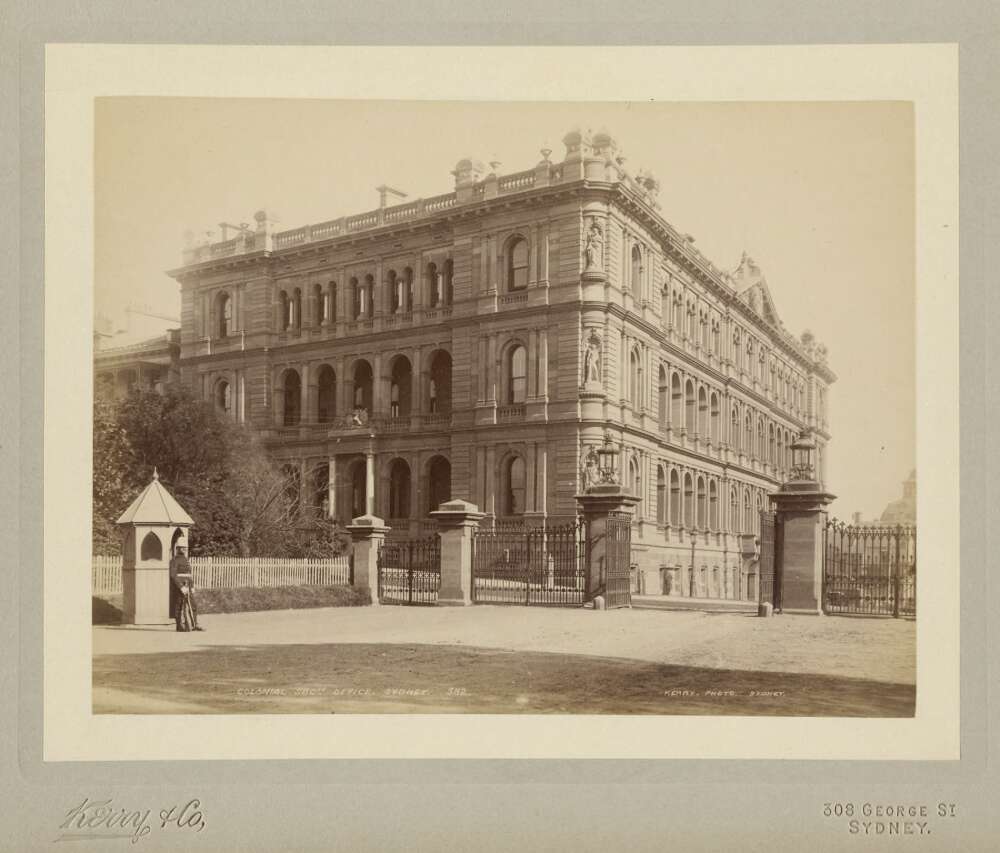
Kerry & Co., Colonial Secretary's Office, Sydney, ca. 1895, nla.gov.au/nla.obj-148351858
Content
Colonial Office classes relating specifically to the colonies has been comprehensively microfilmed. The following list provides, at Class-level, the content of Colonial Office records contained within the AJCP. Piece Lists and Dates may be found in Part 2 of the Handbook.
Auckland Islands
- CO 394 Entry Books of Correspondence [1850-1853)
- CO 714 Index of Correspondence [1812-1870]
- CO 330 Register of Correspondence [1850-1853]
Australia (general)
- CO 418 Original Correspondence
- CO 537 Original Correspondence, Supplementary
- CO 714 Index to Correspondence
- CO 557 Register of Correspondence
- CO 11 Memoranda
- CO 12 Acts
- CO 381 Colonies, General. Entry Books. Series II
Australia (Commonwealth)
Bermuda
Fiji
- CO 83 Original Correspondence
- CO 537 Original Correspondence, Supplementary
- CO 419 Register of Correspondence
- CO 515 Register of Out-Letters
- CO 400 Entry Books of Correspondence
- CO 383 Register of Acts
- CO 85 Sessional Papers
- CO 459 Miscellanea
Gibraltar
Newfoundland
New Guinea (Papua)
- CO 422 Original Correspondence
- CO 578 Register of Correspondence
- CO 579 Register of Out-Letters
- CO 383 Register of Acts
- CO 436 Sessional Papers
New South Wales
- CO 201 Original Correspondence
- CO 714 Index to Correspondence
- CO 360 Register of Correspondence
- CO 369 Register of Out-Letters
- CO 202 Entry Books of Correspondence
- CO 203 Acts
- CO 383 Register of Acts
- CO 204 Sessional Papers
- CO 207 Entry Books Relating to Convicts
- CO 206 Miscellanea
New Zealand
- CO 209 Original Correspondence
- CO 537 Original Correspondence, Supplementary
- CO 714 Index to Correspondence
- CO 361 Register of Correspondence
- CO 365 Register of Out-Letters
- CO 406 Entry Book of Correspondence
- CO 383 Register of Acts
- CO 213 Miscellanea
New Zealand Company
North Australia
Queensland
- CO 234 Original Correspondence
- CO 714 Index to Correspondence
- CO 424 Register of Correspondence
- CO 450 Register of Out-Letters
- CO 423 Entry Books of Correspondence
- CO 383 Register of Acts
South Australia
- CO 13 Original Correspondence
- CO 714 Index to Correspondence
- CO 331 Register of Correspondence
- CO 514 Register of Out-Letters
- CO 396 Entry Books of Correspondence
- CO 383 Register of Acts
- CO 15 Sessional Papers
- CO 17 Miscellanea
Tasmania
- CO 280 Original Correspondence
- CO 714 Index to Correspondence
- CO 370 Register of Correspondence
- CO 371 Register of Out-Letters
- CO 408 Entry Books of Correspondence
- CO 281 Acts
- CO 383 Register of Acts
- CO 282 Sessional Papers
- CO 283 Government Gazette
- CO 284 Miscellanea
Victoria
- CO 309 Original Correspondence
- CO 714 Index to Correspondence
- CO 374 Register of Correspondence
- CO 513 Register of Out-Letters
- CO 411 Entry Books of Correspondence
- CO 383 Register of Acts
- CO 311 Sessional Papers
- CO 313 Miscellanea
Western Australia
- CO 18 Original Correspondence
- CO 714 Index to Correspondence
- CO 332 Register of Correspondence
- CO 353 Register of Out-Letters
- CO 397 Entry Books of Correspondence
- CO 19 Acts
- CO 383 Register of Acts
- CO 20 Sessional Papers
- CO 22 Miscellanea
Australian and New Zealand
Western Pacific
- CO 225 Original Correspondence
- CO 537 Original Correspondence, Supplementary
- CO 492 Register of Correspondence
- CO 493 Register of Out-Letters
Supplementary
Accounts branch
- CO 431 Original Correspondence
- CO 622 Register of Correspondence
- CO 621 Entry Books and Register of Out-Letters
- CO 701 Miscellanea
Chief Clerk
Colonies, general
- CO 323 Original Correspondence
- CO 324 Entry Books of Correspondence, Series I
- CO 381 Entry Books of Correspondence, Series II
- CO 378 Register of Correspondence
- CO 379 Register of Out-Letters
- CO 432 Register of General Miscellaneous Correspondence
- CO 652 Register of Unregistered Correspondence
- CO 694 Register of Secret Correspondence
- CO 570 Secret Entry Books and Register of Out-Letters
- CO 854 Circular Despatches
- CO 816 Original Letters Patent, Warrants, etc.
- CO 380 Draft Letters Patent, Commissions, Royal Instructions, Warrants, etc.
- CO 325 Miscellanea
- CO 862 Register of Replies to Circular Despatches
Correspondence
Dominions
Dominions (War of 1914-1918)
Emigration
- CO 384 Original Correspondence
- CO 385 Entry Books of Correspondence
- CO 386 Records. Colonial Land and Emigration Commission
- CO 428 Register of Correspondence
- CO 485 Register of Out-Letters
Governors' pensions
Honours
Maps and plans
Overseas settlement
Registers
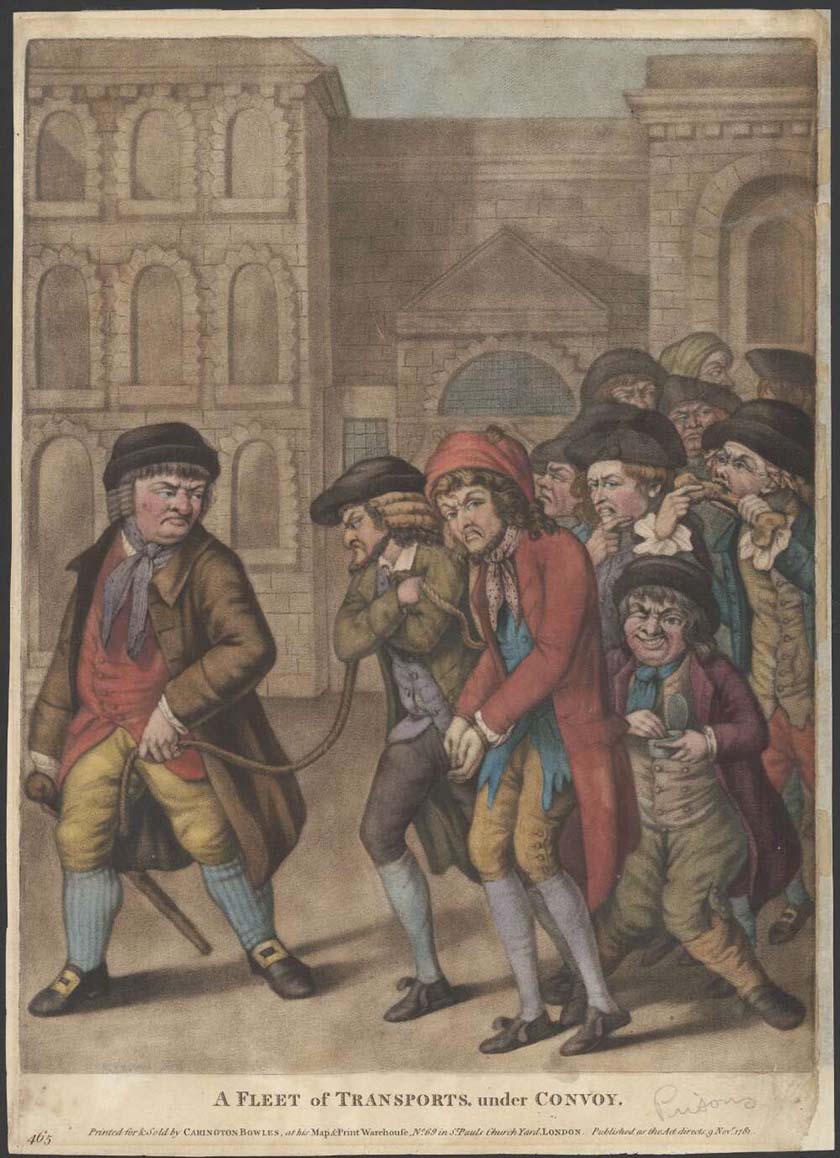
Robert Dighton, (1781), A fleet of transports under convoy, nla.gov.au/nla.obj-135886548
In 1782 the division of foreign business between the Northern and Southern Departments in Great Britain was abolished. Out of this administrative change was born the Home Office, assuming jurisdiction over domestic affairs of the realm.
The functions of the Home Office were then largely the transmission and answering of petitions to the Sovereign from his subjects, advice on the exercise of royal prerogatives, especially the 'prerogative of mercy', and the issuing of instructions on behalf of the Sovereign to Officers of the Crown, Lords Lieutenant, Magistrates, Governors of Colonies and others, in connection with the maintenance of law and order and the defence of the realm. The new Department also immediately became responsible for colonial affairs and remained so until 1801 despite the appointment of a Secretary of State for War and the Colonies in 1794. A number of duties of the Office have since been superseded and other added, control of the penal system being amongst them (1823).
Although the duties of the Home Office have been altered from time to time, the most important as regards Australian historical interest remains that of maintenance of the Sovereign's Peace. Under the sway of this power fall those disturbers of the peace, the convicts. As noted above, the Home Office was responsible for colonial affairs and remained so until 1801, but the bulk of records affecting the colonies has been transferred to the Colonial Office. Most of the remaining records of interest to the Australian Joint Copying Project concern the convicts.
Among the main classes copied can be found the two earliest censuses held in Australia, the 1828 and 1837 censuses.
A digitised copy of Part 3 of the Handbook is available online.
Content
The following list provides, at Class-level, the content of Home Office records contained within the AJCP. Piece Lists and Dates may be found in Part 3 of the Handbook.
Criminal
- HO 7 Convicts, Miscellaneous (1823-1835)
- HO 8 Convict Prisons (1824-1869)
- HO 9 Convict Prisons, Miscellaneous Registers (1802-1849)
- HO 10 Convicts, New South Wales and Tasmania (1788-1859)
- HO 11 Convict Transportation Registers (1787-1870)
- HO 13 Criminal Papers. Entry Books of Correspondence (1786-1871)
- HO 16 Old Bailey Sessions. Returns of Convicted Prisoners (1815-1849)
- HO 25 Entry Books of Correspondence. Public Departments (1850-1871)
- HO 26 Criminal Registers. Series I (1791-1849)
- HO 27 Criminal Registers. Series II (1805-1868)
Various
- HO 28 Correspondence and Papers, Departmental. Admiralty, Correspondence (1784-1838)
- HO 29 Correspondence and Papers, Departmental. Admiralty, Entry Books (1779-1826)
- HO 30 Correspondence and Papers, Departmental. War and Colonial Office (1794-1840)
- HO 31 Correspondence and Papers, Departmental. Council Office (1782-1812)
- HO 34 Correspondence and Papers, Departmental. Public Offices (1836-1871)
- HO 35 Correspondence and Papers, Departmental. Treasury and Customs (1781-1830)
- HO 36 Correspondence and Papers, Departmental. Treasury Entry Books (1785-1849)
Criminal
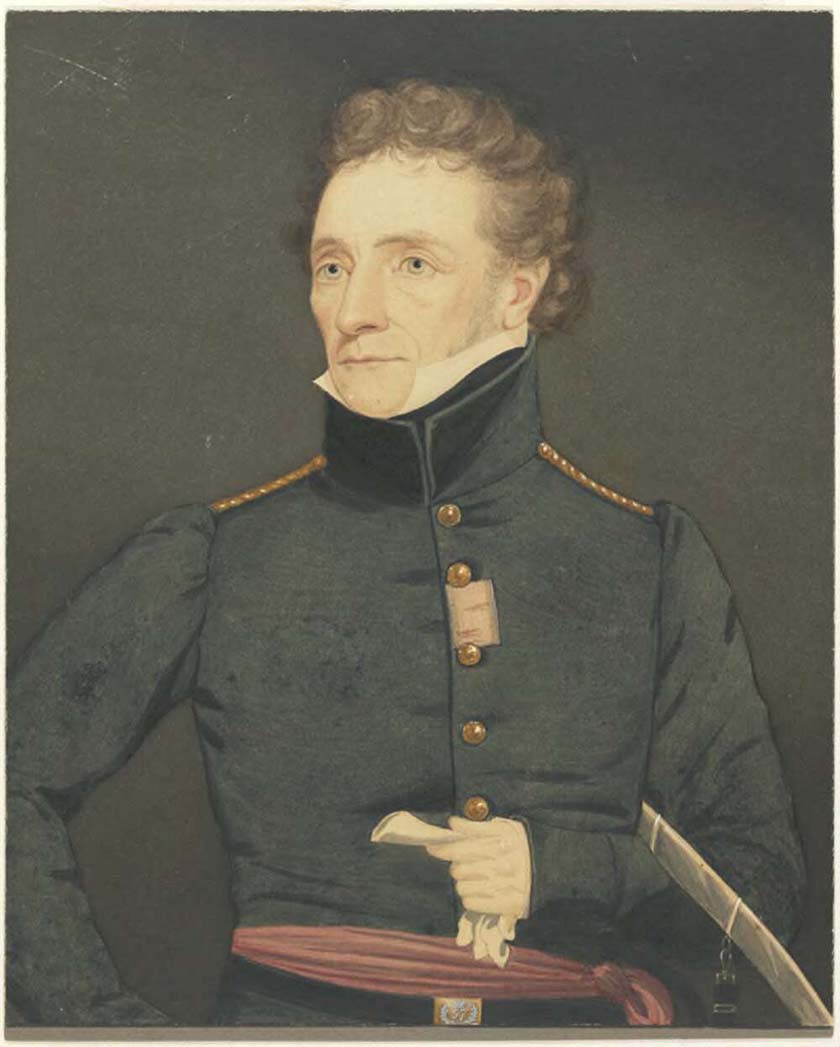
Richard Read, (1830), [Portrait of Colonel James Allan, 57th Regiment], nla.gov.au/nla.obj-135176976
The War Office records copied under the auspices of the Australian Joint Copying Project relate mainly to Australia and New Zealand. Troops in the Colonies were under the control of each Governor, although administratively they were controlled from London. Thus a great deal of material concerning troops and defence, especially before 1840, is to be found in the Governors' despatches in the Colonial Office records. In 1870 the Colonies became responsible for their own defences.
A digitised copy of Part 4 of the Handbook is available online.
Content
The following list provides, at Class-level, the content of War Office records contained within the AJCP. Piece Lists and Dates may be found in Part 4 of the Handbook.
Correspondence
- WO 1 In-Letters (1841-1855)
- WO 3 Out-Letters. Commander-in-Chief (1854)
- WO 4 Out-Letters. Secretary-at-War (1847-1853)
- WO 6 Out-Letters. Secretary of State (1841-1858)
Returns
- WO 10 Muster Books and Pay Lists. Artillery (1845-1870)
- WO 12 Muster Books and Pay Lists. General (1798-1877)
- WO 17 Monthly Returns (1790-1865)
- WO 22 Out-Pensions Records, Royal Hospital Chelsea. Pension Returns (1845-1880)
- WO 25 Registers, Various (1789-1869)
- WO 127 South African War. Local Armed Forces, Nominal Rolls (1901-1902)
Miscellanea
Correspondence
- WO 32 Registered Papers, General Series (1855-1856)
- WO 40 Selected Unnumbered Papers (1802)
- WO 43 Selected 'V.O.S.' and 'O.S.' Papers (1846-1850)
Ordnance Office
Commissariat Department
Private collections
Judge Advocate General's Office
- WO 82 Office Day Books (1817-1863)
- WO 86 Courts Martial. District Courts Martial (1829-1865)
- WO 89 Courts Martial. General Courts Martial (1812-1829)
- WO 90 Courts Martial. General Courts Martial, Abroad (1796-1900)
- WO 92 Courts Martial. General Courts Martial, Registers (1806-1838)
- WO 93 Courts Martial. Miscellaneous Records (1806-1833)
War of 1939-45
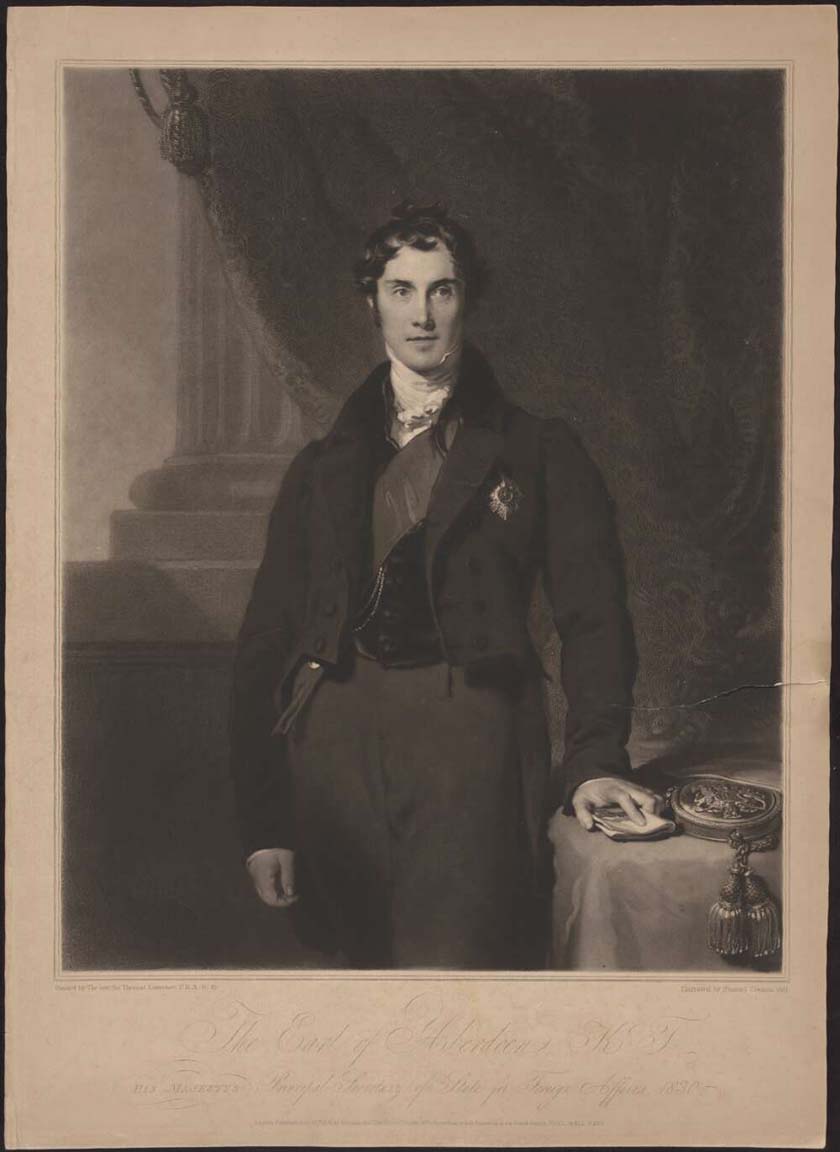
Samuel Cousins & Thomas Lawrence, The Earl of Aberdeen Kt., His Majesty's principal Secretary of State for Foreign Affairs, 1830, nla.gov.au/nla.obj-135976912
Until 1909, no distinction was made between those Foreign Office records created before 1782 and those created after that date. The earlier records were then designated State Papers Foreign, the remainder being classified as the Foreign Office Group. The Foreign Office records filmed under the Australian Joint Copying Project are all records created after 1782. The consist of material dealing with the Pacific area, and correspondence concerning British and other colonial policies and dependencies in the area.
A digitised copy of Part 5 of the Handbook is available online.
Content
The following list provides, at Class-level, the content of Foreign Office records contained within the AJCP. Piece Lists and Dates may be found in the Handbook.
General correspondence
Correspondence before 1906
- FO 5 America, United States of or FO 5 America, United States of
- FO 12 Borneo
- FO 27 France
- FO 37 Holland and Netherlands
- FO 58 Pacific Islands
- FO 64 Prussia and Germany
- FO 67 Sardinia
Correspondence after 1906
Other Classes
Embassy and Consular archives
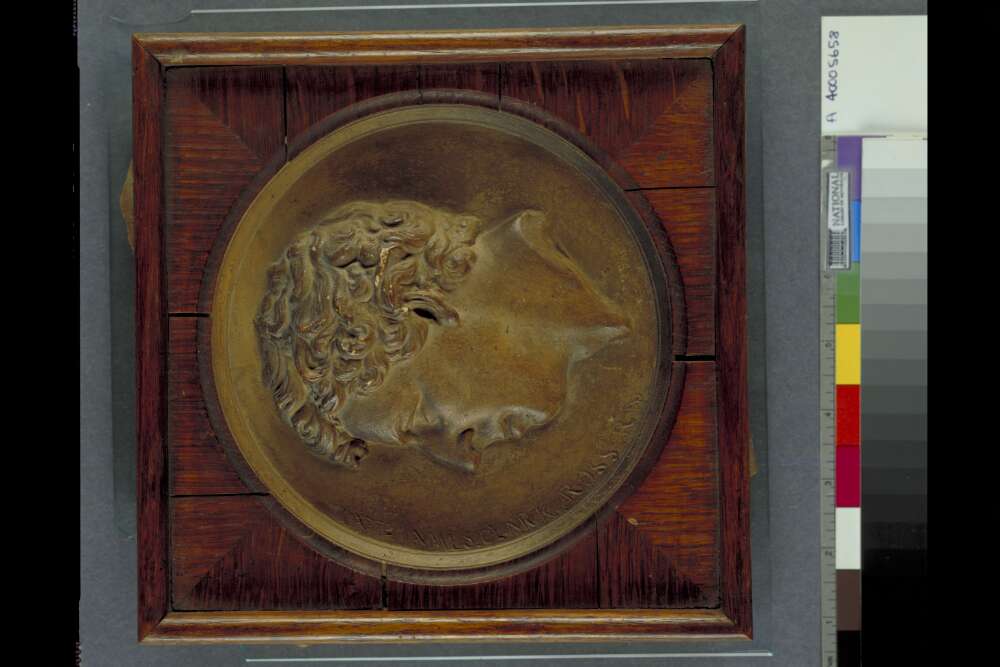
Bernhard Smith, (1845), [Plaque of James Clark Ross RN], nla.gov.au/nla.obj-135734098
In this group of records copied for the Australian Joint Copying Project are those created by the following:
- Air Ministry
- Exchequer and Audit Department
- Meteorological Office
- Board of Trade
- Chancery
- Cabinet Office
- Board of Customs
- Ministry of Labour
- Ministry of Transport
- Privy Council
- Prison Commission
- Paymaster General's Office
- Prime Minister's Office
- British Transport Commission
- Treasury, and
- Board of Longitude
Maps and Plans are also included in this group of records.
A digitised copy of Part 6 of the Handbook is available online.
Content
The following list provides, at Class-level, the content of the various Public Record Office records above that are contained within the AJCP. Piece Lists and Dates may be found in Part 6 of the Handbook.
Air Ministry
- AIR 1 Air Historical Branch. Records. Series I, 1911-31
- AIR 2 Correspondence, 1915-58
- AIR 5 Air Historical Branch. Records. Series II, 1923-29
- AIR 8 Chief of Staff, 1939-53
- AIR 9 Director of Plans, 1926-45
Exchequer and Audit Department
- AO 1 Declared accounts (in rolls), 1791-1822
- AO 2 Declared and passed accounts (in books), 1808-48
- AO 3 Accounts, various, 1789-1845
- AO 4 Registers of accounts received, 1765-1868
- AO 5 Registers of papers received, 1806-1918
- AO 6 Minutes, 1788-1867
- AO 7 Out-Letters. General, 1788-1867
- AO 8 Reports and letters to the Treasury, 1801-67
- AO 9 Office of Comptroller General of the Exchequer. In-letters, 1841-55
- AO 10 Reports to the Board, 1789-1867
- AO 15 Enrolment books, 1788-1845
- AO 16 Miscellaneous, 1787-1826
- AO 17 Absorbed departments, 1798-1847
- AO 19 Accounts current, 1832-1906
- AO 20 Accounts declared before the Chancellor of the Exchequer, 1840-66
- AO 22 Signed and passed accounts, 1848-1900
- AO 23 Reports and letters, 1867-90
Meteorological Office
- BJ 1 Kew Observatory. Correspondence and papers, 1864-69
- BJ 2 Sir James Clark Ross. Correspondence and papers, 1834-60
- BJ 3 Sir Edward Sabine. Correspondence and papers, 1833-75
Board of Trade
- BT 1 In-letters and files. General, 1791-1863
- BT 3 Out-letters. General, 1786-1863
- BT 6 Miscellanea, 1792-1854
- BT 11 Commercial Department. Correspondence and papers, 1923-56
- BT 60 Department of Overseas Trade. Correspondence and papers, 1923-47
- BT 107 Transcripts and transactions. Series I. East India and Australia. 1826-54
- BT 128 Registrar General of Shipping and Seamen. Registers of certificates of competency. Masters and mates: colonial trade, 1872-1921
- BT 135 United Kingdom-Dominion Wool Disposals Ltd, 1946-52
- BT 140 Registrar General of Shipping and Seamen. Registers of certificates of competency. Engineers: colonial, 1877-1921
Chancery
Cabinet Office
- Cab 21 Registered files, 1940-42
- Cab 37 Photographic copies of Cabinet papers, 1902
- Cab 63 Sir Maurice Hankey. Papers, 1915-38
- Cab 133 Commonwealth and international conferences, 1952
Customs
Ministry of Labour
Ministry of Transport
Privy Council
Prison Commission
Paymaster General's Office
Prime Minister
- PREM 3 Operations papers, 1942-43
British Transport Commission
Treasury
- T 1 Treasury Board papers, 1783-1840
- T 7 Colonial affairs, 1849-1900
- T 39 Treasury Chest accounts, 1846-72
- T 46 Victualling lists, 1787
- T 62 Maps and plans. Series I, 1828
- T 64 Various, 1813-27
- T 172 Chancellor of the Exchequor's Office. Miscellaneous papers, 1853-1949
- T 176 Sir Otto Niemeyer. Papers, 1921-27
- T 229 Central Economic Planning Section. Files, 1948-55
- T 236 Overseas Finance Division. Files, 1940-56
- T 247 Lord Keynes. Papers, 1941-46
Board of Longitude, 1714-1838
Maps and plans, 1788-1858
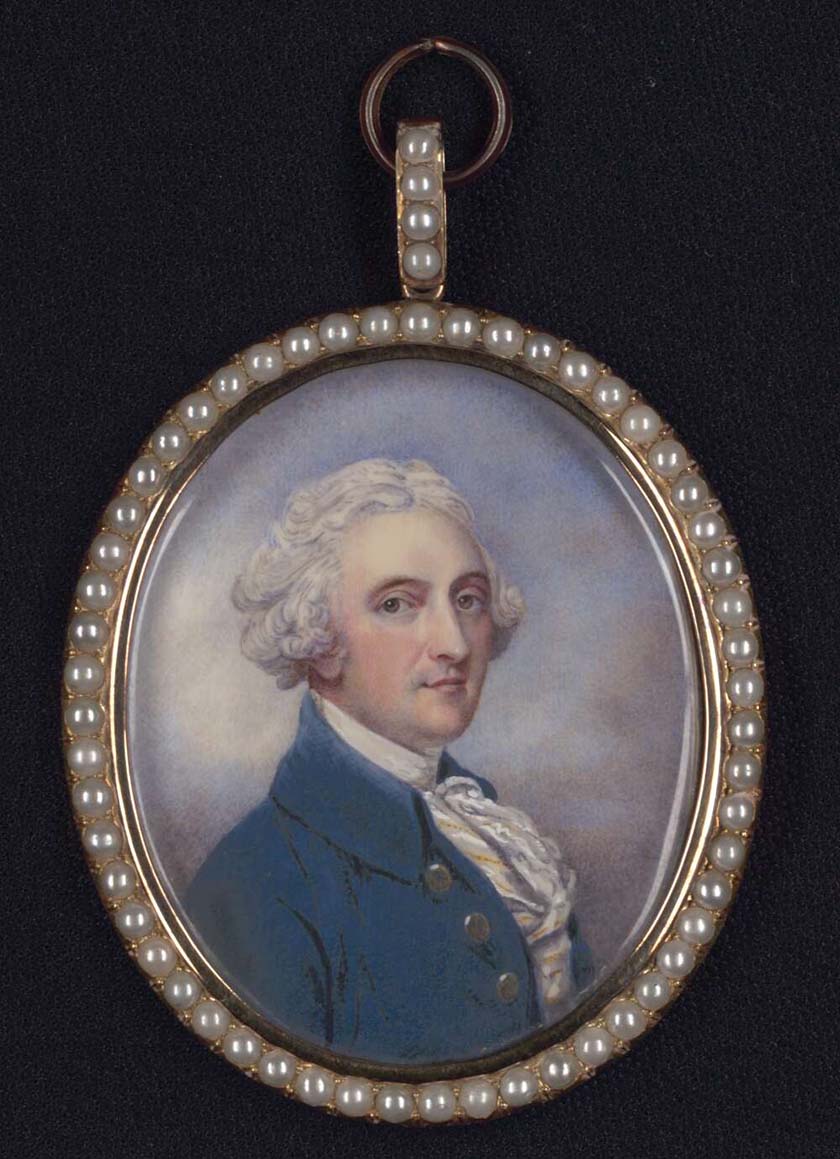
(1743). Portrait of Sir George Jackson, nla.gov.au/nla.obj-149663436
The bulk of the Admiralty records filmed for the Australian Joint Copying Project were grouped by the Public Record Office under the heading 'Admiralty and Secretariat'. The classes included in this section contain records of the Admiralty Office up to 1832 and of the Secretary's Department of the reorganised Board of Admiralty after that date. The types of records microfilmed include correspondence, lists of ships, and log books.
A digitised copy of Part 7 of the Handbook is available online.
Content
The following list provides, at Class-level, the content of Admiralty records contained within the AJCP. Piece Lists and Dates may be found in Part 7 of the Handbook.
Admiralty and Secretariat
- Adm. 1 Papers. New General Series
- Adm. 2 Out-letters
- Adm. 5 Original patents. Vice-Admiralty etc.
- Adm. 6 Registers, returns and certificates. Various
- Adm. 7 Miscellanea
- Adm. 8 Registers, returns and certificates. List books
- Adm. 12 Indexes and compilations. Series III
Accounting departments
Admiralty and Secretariat
- Adm. 51 Log books, etc. Captains' logs
- Adm. 52 Log books, etc. Masters' logs
- Adm. 53 Log books, etc. Ships' logs
- Adm. 54 Log books, etc. Supplementary, Series I. Masters' logs
- Adm. 55 Log books, etc. Supplementary, Series II. Explorations
Royal Marines
Medical departments
Navy Board
Transport departments
Admiralty and Secretariat
Station records
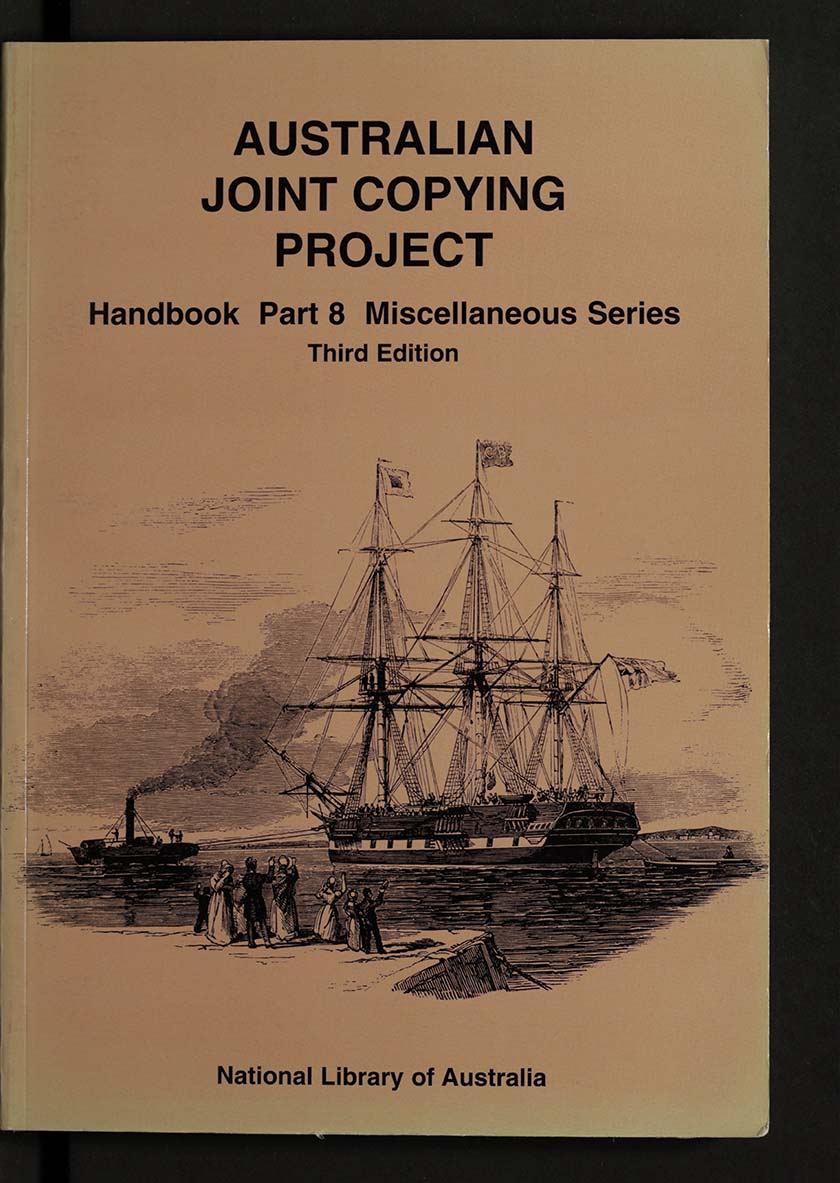
Ekarestini O'Brien & National Library of Australia & Australian Joint Copying Project, (1998), Australian Joint Copying Project handbook, nla.gov.au/nla.obj-397322928
For purposes of arrangement and description the AJCP film is divided into two series: the Public Record Office Series and the Miscellaneous Series.
Archives and manuscripts filmed as part of the Miscellaneous Series range from those held in the British Library and the National Libraries of Wales, Scotland and Ireland to material in university libraries, county record offices, museums, religious archives, learned societies, business archives and private homes. Although private records predominate, the Miscellaneous Series encompasses some official records, including selections from the archives of the Hydrographic Office, the Post Office and the Ministry of Defence. There is also, anomalously, a small amount of film acquired from the Public Record Office. In addition, local government records, mostly relating to convict transportation, were filmed in several county and city record offices.
The great strength of the Miscellaneous Series is in material dating from the nineteenth century. This applies in particular to emigrant diaries and letters, convict records, the archives of missionary societies, scientific records and the papers of politicians and officials. Eighteenth-century material consists mainly of maritime records, including logs and journals of most of the early British explorers in the Pacific. Despite weakening links between Britain and its Pacific colonies, twentieth-century material is far from negligible and includes important sources on imperial relations, migration, trade, public finance, business, wars and defence, and scientific research.
The AJCP staff searched for Australian and Pacific records throughout England and Scotland. The wide coverage is apparent from the list of repositories on pages xii-xix in the handbook. In Wales and Northern Ireland filming was largely confined to the National Library of Wales and the Public Record Office of Northern Ireland. In Ireland the collections searched and filmed were mostly held in repositories in Dublin. No searching was undertaken outside Britain and Ireland. The Miscellaneous Series, however, incorporates a few European collections, especially German official records, which were acquired from various sources.
Most of the records filmed are held in repositories which, whether public or private, are in varying degrees open to the public. The remainder are personal papers which are in the possession of individuals or families. They range from the papers of well-known explorers and governors to letters and diaries sent back to Britain by ordinary emigrants and travellers.
Brief descriptive entries for each of the records filmed as part of the Miscellaneous Series can be viewed in Part 8 of the Handbook.
A digitised copy of Part 8 of the Handbook is available online.
Content
Brief descriptive entries for each of the records filmed as part of the Miscellaneous Series can be viewed in Part 8 of the Handbook. In addition to the Handbook the Library holds descriptive lists of the content of each entry. These lists are contained in 35 bound volumes which are available for consultation in the Newspapers and Family History zone.
Other libraries that hold copies of the AJCP Miscellaneous Series microfilms
At the time of publication of the third edition of the M Series Handbook in 1998, the following institutions held all or part of the M Series microfilms.
Australia
Australian Capital Territory
- Australian Academy of Science: Basser Library
- Australian War Memorial
- High Court of Australia Library
- National Gallery of Australia
- National Library of Australia (COMPLETE)
New South Wales
- Archives Authority of New South Wales
- Australian Genealogical Education Centre, Kiama
- Australian National Maritime Museum
- Catholic Institute of Sydney
- Charles Sturt University Regional Archives
- Charles Sturt University: Wagga Campus Library
- Macquarie University Library
- Philatelic Association of New South Wales Library
- Randwick City Council Library Services
- Royal Botanic Gardens, Sydney
- Society of Australian Genealogists
- State Library of New South Wales - Mitchell Library (COMPLETE)
- University of New England Library
- University of New South Wales Library
- University of Newcastle - Auchmuty Library
- Wollongong City Library
Northern Territory
- Northern Territory Library Service
- Wadeye Community Library, Port Keats
Queensland
- Department of Geographic Information
- James Cook University of North Queensland Library
- State Library of Queensland: John Oxley Library
- University of Central Queensland Library
- University of Queensland Library
- University of Queensland: Department of History
- University of South Queensland Library
South Australia
- Flinders University of South Australia Library
- State Library of South Australia: Mortlock Library
- State Records of South Australia
- University of Adelaide: Barr Smith Library
Tasmania
- Archives Office of Tasmania
- Port of Launceston Authority
- State Library of Tasmania
- University of Tasmania Library
Victoria
- Australian Gallery of Sport and Olympic Museum
- Deakin University Library
- Genealogical Society of Victoria
- Public Record Office
- State Library of Victoria: La Trobe Library (COMPLETE)
- University of Melbourne: Department of History
Western Australia
- Library and Information Services of Western Australia: Battye Library (now State Library of Western Australia)
- Murdoch University Library
- University of Western Australia Library
New Zealand
- Auckland Institute and Museum
- Auckland Public Library
- College of St John the Evangelist
- National Archives of New Zealand
- National Library of New Zealand: Alexander Turnbull Library
- University of Auckland Library
- University of Canterbury Library
- University of Otago: Hocken Library
Papua New Guinea
- University of Papua New Guinea Library
Fiji
- Fiji Museum
- Pacific Theological College
United States of America
- East-West Center, Hawaii
- University of Hawaii Library
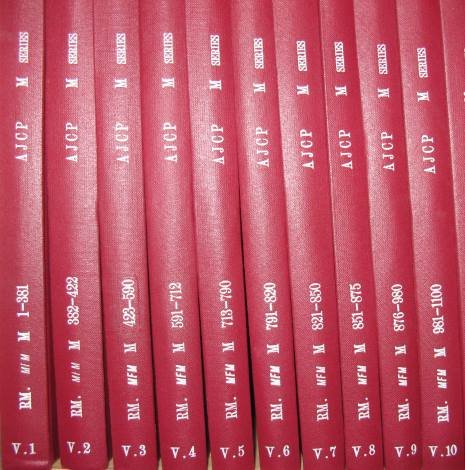
Descriptive lists of M Series records
Descriptive lists of M Series records are contained in 35 bound volumes and are available for consultation in the Newspapers and Family History zone. In a number of cases the online versions of lists contain more detail than those in the printed volumes.
The following are a selection of descriptive lists now available for viewing online, arranged in M Series reel number order.
- M 1-116, M 608-70 London Missionary Society
- M 118-172C, M988-991 Methodist Missionary Society (records)
- M 173-243, M 1825-1827 Church Missionary Society
- M 244-290 German Foreign Ministry
- M 291-336A German Navy
- M 337-364, M 585-589 Van Diemen's Land Company
- M 367-372 Lawrence Hargrave
- M 373-376 John B Graham
- M 377-380, M 390 Gell and Franklin Families
- M 381 Bishop Mathew B Hale
- M 382-383 Marsden Family
- M 384 John G Petingale
- M 385 John Campbell
- M 386 Sanford Family
- M 387-388, M 1660-1666 Public Record Office of Northern Ireland
- M 389 Armagh County Museum
- M 391 Thomas Fyshe Palmer
- M 392 Holyoake Family
- M 394 David Beath
- M 395-396 Gardiner Family
- M 397 Thomas Baines
- M 398 Robert Lowe
- M 399 Leslie J Wilmoth
- M 400 Edward Robarts
- M 401 John Lovell
- M 402 Vyvyan Family
- M 403 Captain Charles Sturt
- M 404 Evelyn Pitfield Sturt
- M 405 Frederick Hoare
- M 406 Hydrographic Department
- M 407-409, M 593, M 718 Captain T.G.S. Ward
- M 411 Edward Arnold
- M 412 Sir Anthony Musgrave
- M 413-416, M 577-579 Commonwealth and Continental Church Society
- M 417 Janet D Hine
- M 418-420, M 422 Lists of Colonial Office records
- M 423 Ex-Canterbury resident
- M 424 British Museum. Department of Ethnography
- M 425-432 Society of Mary
- M 433 National Westminster Bank
- M 435 George Kershaw
- M 436 David Atkinson and other New South Wales settlers
- M 437 John Fitzsimmons
- M 437 John P Ricou
- M 440 Mathilde Deane
- M 444 Captain Matthew Flinders
- M 445 Captain Charles Swanston
- M 446-458 Colonial Office: Straits Settlements
- M 460 Macquarie Family
- M 461 Mitchell Library
- M 462 John Grant
- M 463 Stanley Family
- M 464 Captain Francis Cadell
- M 465 Captain Henry M Denham
- M 466 Thomas Mellesh
- M 467 Reverend Henry Stobart
- M 468 British Women's Emigration Association
- M 469 Sir Joseph Banks
- M 470-535 East India Company
- M 536-549 Methodist Missionary Society (publications)
- M 550-576 Frederick Danvers
- M 580, M 1363-1367 Corporation of London Record Office
- M 581 Middlesex County Record Office
- M 582-583 Robert Brooks and Co
- M 584, M 985-986 Scottish Record Office
- M 590, M 1093-1100 Bishop George A. Selwyn
- M 591, M 821, M 1659-1660 Bedfordshire Record Office
- M 592 Sir Edward Macarthur
- M 594 Sir Frederick Barlee
- M 595 Charles Meryon
- M 596-597 Linnean Society of London
- M 598 Patrick Morris
- M 599 Gerald Wheeler
- M 600, M687-688 James C. Crawford
- M 602 Edward Ashworth
- M 603 Michael Dwyer
- M 604 Sir Everard Home
- M 605 Commodore John Byron
- M 606-607, M 671 Sir William Denison
- M 672-673 Sir Charles Gavan Duffy
- M 674 Henry Harding
- M 675, M 789-790 Sir Arthur Hodgson
- M 677 Archbishop John Moore
- M 678 John Lee
- M 679 Lt Col William Temple
- M 680 John Watts
- M 681-686 School of Oriental and African Studies
- M 689-690 Sir George Grey
- M 691 Sir John Thurston
- M 692 Allan Cunningham
- M 708-712 Royal Naval Hospital, Haslar
- M 713, M 866 Berkshire Record Office
- M 714 Jonathon Bennett - Logbook of the ship Margaret, 1850-52
- M 715 Bishop Edmund Hobhouse
- M 716 Sir Dudley De Chair
- M 717 Lieutenant Graham De Chair
- M 719 Peregrine Massingberd
- M 720 Mann Family
- M 721 Reverend William Edgell
- M 722 Captain James Cook
- M 723 Jeffcott and Kermode Families
- M 724 John Bond
- M 725-727 John Gould
- M 728 Reverend Henry Welchman
- M 729 Reverend Francis Hodgson
- M 730-788 Royal Botanic Gardens, Kew
- M 791-793 Derby Central Library
- M 794-801 German Embassy in London
- M 802-806 Melanesian Mission
- M 807-814, M 828 Sir Timothy Coghlan
- M 815 South Staffordshire Regiment
- M 816-819 East Sussex Record Office
- M 820 Hove Central Library
- M 822, M 1549-1550 West Sussex Record Office
- M 823 Petworth House Archives
- M 824 John W. Blencowe
- M 825-827, M 2118 Birmingham Central Library
- M 829 Staffordshire Record Office
- M 830 Edmund Peters
- M 831 William Salt Library
- M 832 Thomas M. Reade
- M 833 Sir John Murray
- M 834 George Siddells
- M 835 Sir Edmund Du Cane
- M 836 Hayward Family
- M 837 Federick Edelsten
- M 838-840 Essex Record Office
- M 841 George Everett
- M 844 Thomas Robinson
- M 845-847 Cheshire Record Office
- M 848 Chester City Record Office
- M 849-850 John Brown
- M 851 Anne Hale
- M 852 Sir Thomas Larcom
- M 853 William Blandowski
- M 854 Trinity College Library, Dublin
- M 855 Heathfield Stephenson
- M 856 James Roberts
- M 857 W J Cotton
- M 858 Brown family
- M 864 James White
- M 865 Co-operative Union Ltd
- M 867-868 University of Birmingham Library
- M 869-870 Liverpool City Libraries
- M 871-874 All Hallows College
- M 875 Sir Saul Samuel
- M 876-916 Thomas Huxley
- M 917-932 Lord Carrington
- M 933 Arthur Bowes Smyth
- M 934 William C. Wills
- M 935 Wiltshire Record Office
- M 936-937, M 1154-1156, M 1584 Lord Hopetoun
- M 938, M 974 Sir John Lefroy
- M 939 Thomas Fielden
- M 940 Wilson Family
- M 941-943 Suffolk Record Office (Ipswich)
- M 944 Margaret Catchpole
- M 945-946 Royal Irish Academy
- M 947 Derbyshire Record Office
- M 948-970 Sir Thomas Cochrane
- M 971 David Blackburn
- M 972 James Pettet
- M 973 Suffolk Regiment Association
- M 975 Foster and Braithwaite
- M 976 Lord Monteagle
- M 977 Stephen Brennand
- M 978 James Craig
- M 979 George Pearson
- M 980 Louis Hope
- M 981, M 2315-2317 Norfolk Record Office
- M 982 Suffolk Record Office (Bury St. Edmunds)
- M 983, M 2078 Cumbria Record Office
- M 984 Genealogical Office, Dublin
- M 987 Captain Edward Frome
- M 992 Sir Paul Edmund Strzelecki
- M 993-994 Rev Robert Codrington
- M 995-999 Downside Abbey
- M 1000-1092 New Zealand and Australian Land Company
- M 1131 Alexander Turner
- M 1134 Beaumont Featherston
- M 1135 John Smith
- M 1157 Andrew Holden
- M 1185 Sir William Jervois
- M 1194 Free Church of Scotland
- M 1198 Brigadier Arthur Shakespear
- M 1201-1335, 1401-1516 United Society for the Propagation of the Gospel
- M 1557 Hernando Gallego
- M 1558 Abel Tasman
- M 1559-1574 Pacific Voyages (British Library)
- M 1580-1582 Captain James Cook
- M 1583 David Samwell
- M 1615-1616 Denison family
- M 1620-1627 India Office Library
- M 1650 Lever Brothers Ltd
- M 1877 Brown Family
- M 1923 Foreign & Commonwealth Office Library
- M 2090 Robert Thomas
- M 2125-2229 National Archives of Ireland
- M 2254 Henderson Family
- M 2415-2421 Makereti
- M 2512 Albert Meek
- M 2727 R W Paine
- M 2766 York Minster Library
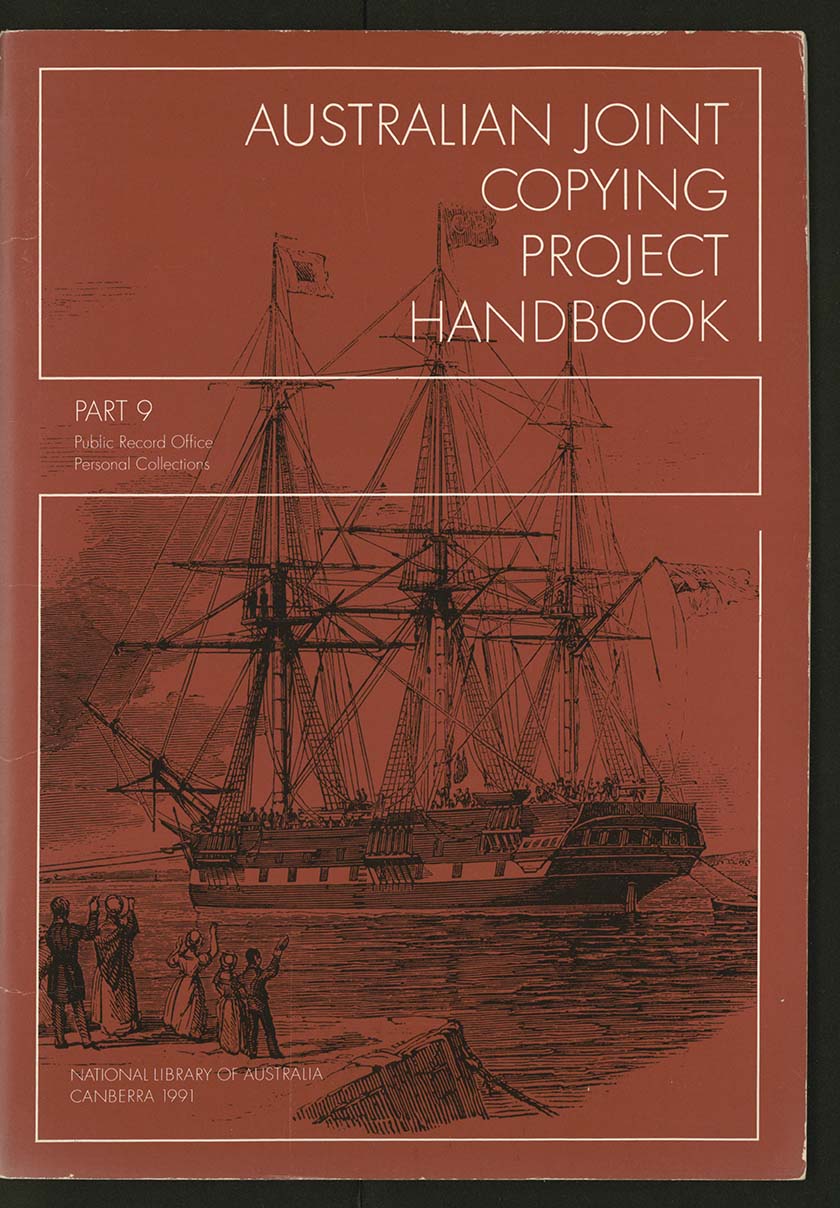
National Library of Australia, (1991), Australian Joint Copying Project handbook, nla.gov.au/nla.obj-397324021
Records acquired by the Public Record Office by means of gift, deposit or purchase from individuals, families or organisations have been placed in a special class, PRO 30. Most of the collections in the class comprise papers of individuals who had some involvement in public life.
The Australian Joint Copying Project has filmed papers in the following nine collections in PRO 30:
- PRO 30/6 Carnarvon Papers, 1858-85
- PRO 30/8 Pitt Papers, 1766-1808 (Chatham Papers)
- PRO 30/9 Abbot Papers, 1799-1802 (Colchester papers)
- PRO 30/22 Russell Papers, 1835-75
- PRO 30/29 Granville Papers, 1822-86
- PRO 30/45 Hatton Papers, 1779-1854
- PRO 30/48 Cardwell Papers, 1848-73
- PRO 30/56 Northcote Papers, 1904-08
- PRO 30/68 Anderson Papers, 1916-29
Two of the above collections, the Hatton and Northcote Papers, being small collections, have been filmed in their entirety.
Each of these collections has distinctive features. The Hatton Papers are an artificial collection, in that the records were Home Office official papers which for some reason passed out of custody of the Home Office and were ultimately acquired by Joseph Hatton. The Northcote Papers are distinctive in that they were assembled in Australia rather than Britain, the letters all relating to Lord Northcote's term as Governor-General. Although only three correspondents are represented in the collection, no other personal papers of Lord Northcote are known to have survived.
The other seven collections have all been filmed selectively and in some cases the selections form a very small proportion of the total collection. Of the seven individuals who assemble the papers, six were British politicians, including two Prime Ministers (William Pitt and Lord John Russell) and four Secretaries of State for the Colonies (Russell, Edward Cardwell, Lord Granville, Lord Carnarvon). The subject matters of these political collections vary considerably. The Pitt Papers, the only eighteenth century collection, contains documents on the first British settlement in Australia, the establishment of the Pacific whale fishery, and British economic and strategic interests in South East Asia. The papers filmed in the other collections include material on convicts and transportation (Abbot, Russell), appointments of governors, self-government for the colonies (Russell, Carnarvon), the withdrawal of imperial troops from the colonies (Cardwell, Granville), and British interests and annexations in New Guinea and the Pacific (Russell, Carnarvon, Granville).
The remaining collection is somewhat different in that it dates from the twentieth century, was assembled by an official and businessman, Sir Alan Anderson, and deals with a single subject, the shipment of Australian wheat to Britain during World War I.
Detailed Piece Lists and Dates for the above collections may be found in Part 9 of the Handbook.
A digitised copy of Part 9 of the Handbook is available online.
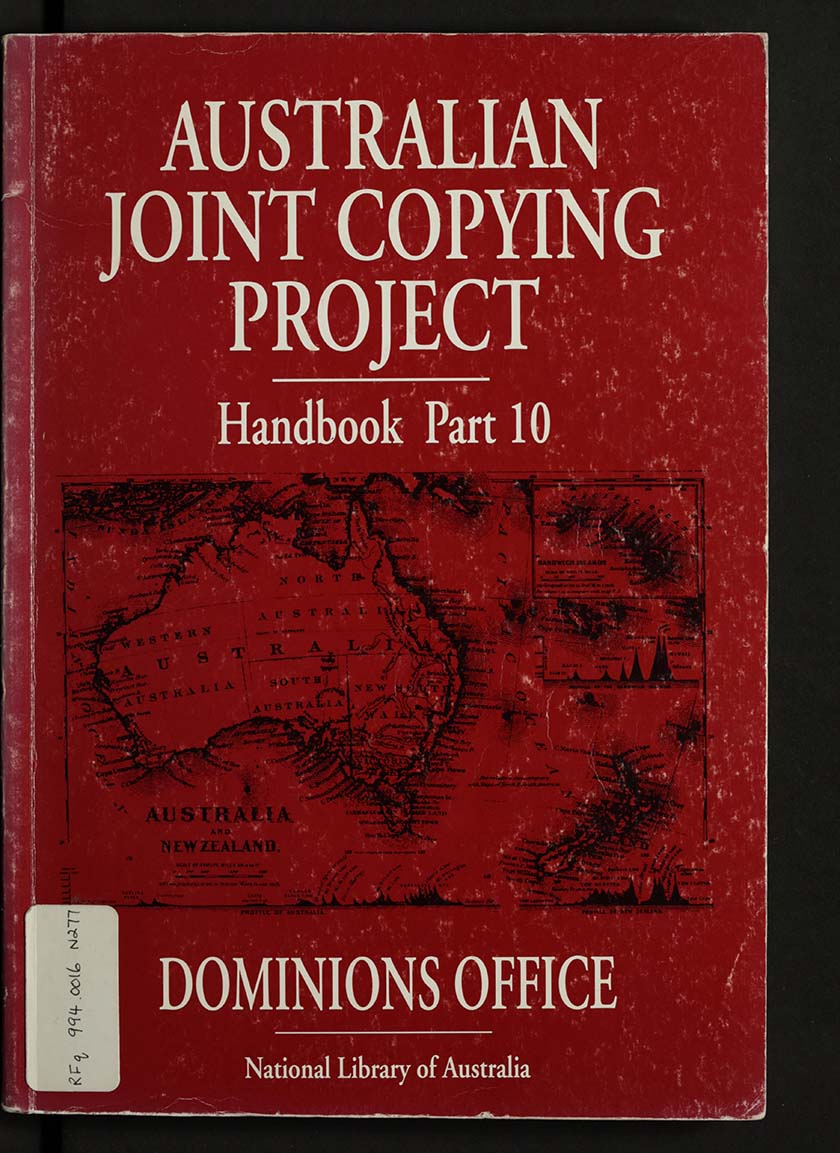
National Library of Australia, (1991), Australian Joint Copying Project handbook, nla.gov.au/nla.obj-397330275
The records filmed by the AJCP. and listed in this Handbook span the period 1924-51. They include virtually all the surviving Dominions Office records relating to Australia and New Zealand and the bulk of the records concerning the other Dominions for the years 1925-46. The records document the complexity of imperial relationships during a volatile period of world history and cover and extraordinary range of subjects: politics, constitutional crisis, public administration, defence, World War II, trade, economic affairs, communications, migration, foreign relations, race relations and many others.
A digitised copy of Part 10 of the Handbook is available online.
Content
The following list provides, at Class-level, the content of Dominion Office records contained within the AJCP. Piece Lists and Dates may be found in Part 10 of the Handbook.
- DO 35 Dominions. Original Correspondence, 1926-29
- DO 35 Dominions. Original Correspondence, 1930-36
- DO 35 Dominions. Original Correspondence, Newfoundland, 1934-36
- DO 35 Dominions. Original Correspondence, 1937-42
- DO 35 Dominions. Original Correspondence, 1943-46
- DO 35 Dominions. Original Correspondence, Secret Despatches, 1943-46
- DO 57 Overseas Settlement. Original Correspondence, 1925-36
- DO 114 Confidential Print. Dominions, 1924-51
- DO 115 Confidential Print. Dominions (Australia), 1928-36
- DO 117 Supplementary Original Correspondence, 1926-29
- DO 121 Private Office Papers, 1924-51
- DO 126 High Commission and Consular Archives, Australia. Correspondence, 1931-41
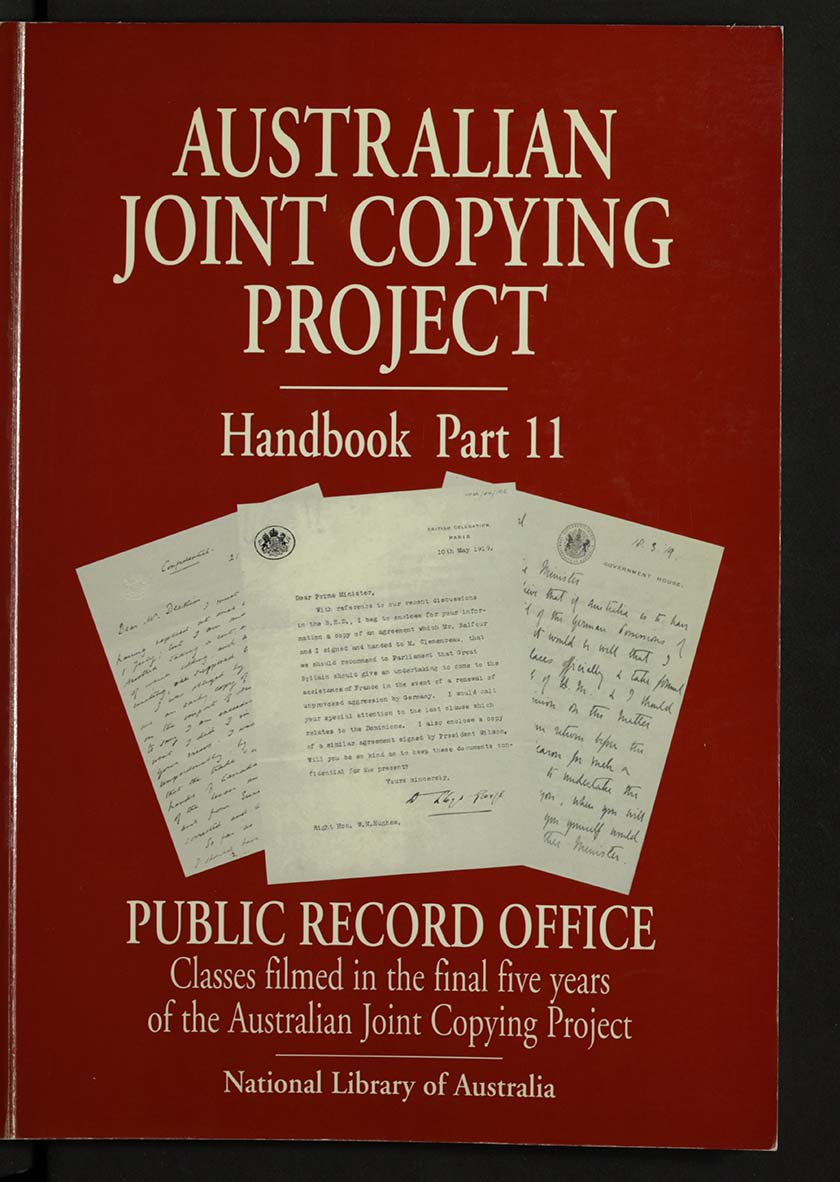
Ekarestini O'Brien & National Library of Australia & Australian Joint Copying Project, (2005), Australian Joint Copying Project handbook, nla.gov.au/nla.obj-397331344
Between 1984 and 1993 Handbooks were published listing records of the Admiralty (Part 7), Colonial Office (Part 2), Dominions Office (Part 10), Foreign Office (Part 5), Home Office (Part 3) and War Office (Part 4). In addition, Part 9 described the personal collections held at the Public Record Office that have been filmed by the AJCP.
In the final few years of the Project, further records of these departments were filmed. Unfortunately, it was not feasible to issue new editions of seven parts of the Handbook to incorporate these additions. Instead, they have been grouped together in Part 11, which completes the publication of the Handbook.
In should be noted that in 2003 the name of the Public Record Office was changed to the National Archives (https://www.nationalarchives.gov.uk/).
A digitised copy of Part 11 of the Handbook is available online.
Content
The following list provides, at Class-level, the additional Public Record Office content contained within the AJCP. Piece Lists and Dates may be found in Part 11 of the Handbook.
Admiralty
- Adm 1 Admiralty and Secretariat. Papers, 1913-57
- Adm 36 Ships' musters, 1739-1807
- Adm 106 Navy Board. Records, 1771-1832
- Adm 199 War history cases and papers, 1935-46
Colonial Office
- CO 225 Western Pacific. Original correspondence, 1914-51
- CO 323 Colonies, General. Original correspondence, 1818-1925
- CO 378 Colonies, General. Registers of correspondence, daily, 1878-1908
- CO 381 Colonies, General. Entry books, Series 2
- CO 382 Registers, Correspondence, daily
- CO 384 Emigration. Original correspondence, 1830-96
- CO 385 Emigration. Entry books of correspondence, 1834-96
- CO 386 Emigration. Land and Emigration Commission, etc., 1838-69
- CO 406 Entry books of correspondence, 1863-72
- CO 537 Supplementary. Selections of original correspondence, 1943-51
- CO 687 Dominions, War of 1914-1918: trade. Original correspondence, 1916-19
- CO 693 Prisoners. Original correspondence, 1917-19
- CO 700 Manuscript maps relating to Australia, New Guinea and New Zealand, 1801-49
- CO 752 Dominions, War of 1914-1918. Register of correspondence, 1914-19
- CO 753 Dominions, War of 1914-1918. Register of out letters, 1914-19
- CO 754 Dominions, War of 1914-1918. Prisoners. Register of correspondence, 1917-19
- CO 755 Dominions, War of 1914-1918. Prisoners. Register of out letters, 1917-19
- CO 756 Dominions, War of 1914-1918. Trade. Register of correspondence, 1916-19
- CO 757 Dominions, War of 1914-1918. Trade. Register of out letters, 1916-19
- CO 852 Economic. Original correspondence, 1934-53
Dominions Office
Foreign Office
- FO 5 Correspondence. United States of America, 1840-1905
- FO 64 Correspondence. Prussia and Germany, 1870-1905
- FO 97 Supplement to general correspondence, 1862-1900
- FO 371 General correspondence. Political, 1906-24, 1952
- FO 608 Peace Conference of 1919-1920. Original correspondence, 1919
- FO 800 Personal collections
Home Office
- HO 7 Convicts, Miscellaneous, 1785
- HO 42 Correspondence and papers: domestic and general. George III, 1782-1820
War Office
- WO 11 Muster rolls and pay lists: Royal Engineers, 1843-78
- WO 12 Returns. Muster books and pay lists (general), 1818-37
- WO 25 Registers, various. Services to officers on full pay, 1829-41
- WO 32 Registered papers: General series. Records relating to Australia, New Zealand and the Pacific, 1858-1954
- WO 127 South African War. Local armed forces, nominal rolls, 1901-02
- WO 203 War of 1939-1945. Military headquarters papers: Far East, 1943-47
- WO 235 Judge Advocate-General's Office. War of 1939-1945. War crime papers, 1946-48